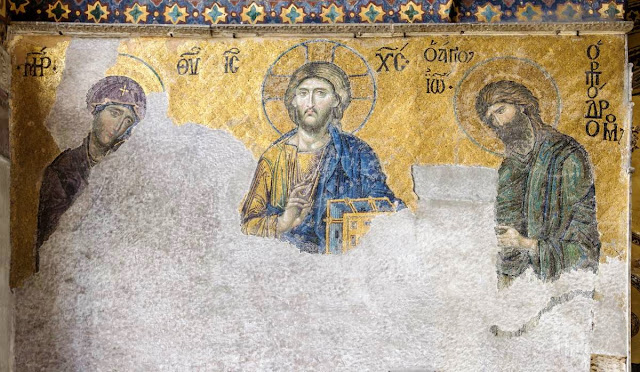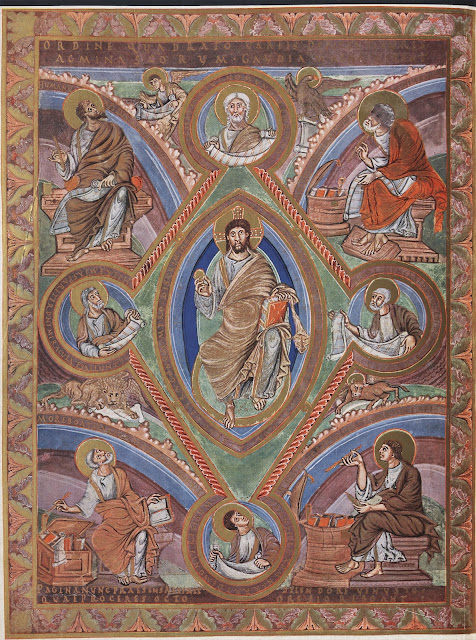 |
Masseot Abaquesne, The Flood
French, c. 1550
Ecouen, Musée national de la Renaissance |
Jesus said to his disciples:
“As it was in the days of Noah,
so it will be at the coming of the Son of
Man.
In those days before the flood,
they were eating and drinking,
marrying and giving in marriage,
up to the day that Noah entered the ark.
They did not know until the flood came and
carried them all away.
So will it be also at the coming of the Son
of Man.
Two men will be out in the field;
one will be taken, and one will be left.
Two women will be grinding at the mill;
one will be taken, and one will be left.
Therefore, stay awake!
For you do not know on which day your Lord
will come.”
Matthew
24:37-42
(Excerpt
from the Gospel for the First Sunday of Advent, Year A)
The Sunday lectionary (book of liturgical readings) of the Catholic Church contains the readings for each Sunday Mass during the liturgical year, which stretches from the first Sunday of Advent to the solemnity of Christ, the King of the Universe. It is arranged in a three year cycle, which means that excerpts from the Gospel of Matthew are read during the first year, labeled A. Excerpts from the Gospel of Mark are read in the second Year B and excerpts from the Gospel of Luke are read in the third, Year C. We have just completed one three year cycle and begin a new one this coming Sunday. The comments on the iconography suggested by this first week of Year A follow below.
The
admonition in the Gospel for the First Sunday of Advent, Year A to “Stay
Awake! For you do not know on which day
your Lord will come” brings with it the reminder that “as it was in the days of
Noah, so it will be at the coming of the Son of Man”, people went on with their
lives, unaware of the catastrophe that was about to fall on them in the
Flood. And so it always is. We have ample evidence in contemplating the
disasters of the past and of the present.
There is abundant proof that the people of Pompeii and the other towns
at the foot of Vesuvius went about their lives right up to their burial in
layers of ash and mud. The mega tsunami
in Indonesia in 2004 caught people eating breakfast or relaxing in their hotel
pools as it crashed into them. The
Japanese earthquake and tsunami that devastated Fukushima hit when no one was
expecting it. Similarly, the recent
highly damaging earthquakes in Italy have come in the middle of the night. And we have certainly seen in our own country
the devastating effect of flood waters, with Hurricanes Katrina, Sandy and
other weather events.
 |
Bonaventura Peeters, The Great Flood
Dutch, c. 1630-1650
Private Collection
|
If we have
no way of really preparing for and protecting ourselves from natural disasters,
there is little likelihood that we will be completely prepared for the day of
the Lord. I have always been mildly
amused by the occasional warnings that the world will end on such and such a
date. In the verse just before the start
of this Sunday’s Gospel passage, Jesus tells his disciples “But of that day and hour no one knows, neither the angels of heaven,
nor the Son, but the Father alone.” (Matthew 24:36). If He himself
does not know, how can anyone else, no matter by what means they claim the
knowledge. Consequently, it is a good
idea to heed Jesus’ warning and “Stay awake” with prayer, good works, both
physical and spiritual, and an expectant heart.
This is the message of Advent, not one of fear, but of hope and
expectation.
.jpg) |
Mosaic, The Flood
Italian, c. 1215-1235
Venice, Basilica of San Marco |
Images of the Flood
Over the
centuries artists have confronted this warning in several ways. They have shown us images of the final
resurrection and of the Last Judgment, but only a relative few have addressed the
central image of this Sunday’s reading, the Great Flood and the time just
before it, when the actions of humanity prompted such a violent reaction.
In this essay I am talking about images of the Flood in itself, not about the story of Noah. There are many, many images of the story of Noah, from the warning he received from God, to his struggle to build the ark. And there are many, many images showing the animals entering the ark, the ark floating in the waters, the sending of the raven and the dove, the landing on Ararat, the exit of Noah, his family and the animals from the ark and the resettlement of the earth. However, I am not referring to them directly here.
 |
Jacopo Torriti, Scenes from the Old Testament, The Building of the Ark
Italian, c.1290
Assisi, Basilica of San Francesco, Upper Church |
There is a
steady stream of images of the Flood itself through time, beginning in the
thirteenth century and running through time.
The earliest images seem to show the effects of the flood at its height,
as well as of Noah’s preparations. We
are shown the bodies of humans and animals floating amid the ruins of
buildings, while a few who still survive are shown trying to swim.
 |
The Deluge
From De Civitate Dei by Saint Augustine
French (Paris), c. 1400-1425
Paris, Bibliotheque nationale de France
MS Francais 174, fol. 83r |
 |
The Deluge
From De Civitate Dei by Saint Augustine
French (Paris), c. 1400-1425
Paris, Bibliotheque nationale de France
MS Francais 173, fol. 70v |
 |
Master of Jouvenel des Ursins and collaborators, The Deluge
From Mare historiarum of John of Cologne
French (Anjou), c. 1447-1455
Paris, Bibliotheque nationale de France
MS Latin 4915, fol. 25r |
 |
Maitre de l'echevinage and collaborators, The Deluge
From De Civitate Dei by St. Augustine
French (Rouen). c. 1450-1475
Paris, Bibliotheque nationale de France
MS Francais 28, fol. 66v |
 |
Lucas Cranach the Elder and the Younger, The Flood
German, c. 1531-1539
Schneeberg, St. Wolfgang's Church |
Trying to Escape
Around the
middle of the fifteenth century these images are joined by others that focus on
the attempts of the population to escape the rising waters. These pictures are often highly dramatic,
with the drama increasing markedly as time passed.
2.jpg) |
Paolo Uccello, The Flood
Italian, c. 1447-1448
Florence, Church of Santa Maria Novella. Green Cloister
|
|
2.jpg) |
Anonymous, The Flood
Possibly Italian, c. 1450-1500
Amsterdam, Rijksmuseum |
 |
Circle of Marten van Cleve the Elder, The Flood
Flemish, 16th century
St. Petersburg, State Hermitage Museum |
 |
Michelangelo, The Flood
Italian, c. 1508-1509
Vatican City, Apostolic Palace, Sistine Chapel |
 |
Jan van Scorel, The Flood
Dutch, c. 1530
Madrid, Museo del Prado |
 |
The Flood From The Story of Noah Tapestry Series Flemish, c. 1550-1600 St. Petersburg, State Hermitage Museum |
 |
The Great Flood Tapestry
Flemish, Early 17th Century
St. Petersburg, State Hermitage Museum |
 |
Antonio Caracci, The Flood
Italian, c.1600
Paris, Musée du Louvre |
 |
Alessandro Turchi, The Flood
Italian, c.1630
Paris, Musée du Louvre |
 |
David Teniers II, The Deluge
Flemish, c.1655
Lawrence, KS, Spencer Museum of Art-The University of Kansas
|
|
 |
Nicolas Poussin, Winter or the Flood
French, c. 1660-1664
Paris, Musée du Louvre |
Many of these pictures, especially those from the eighteenth, nineteenth and early twentieth centuries are dramatically posed.
 |
Louis Dorigny, The Flood
French, 1700-1703
Venice, Palazzo Tron |
 |
Mattia Bortoloni, The Flood
Italian, 1717-1718
Piombino Dese, Villa Cornaro |
 |
Jacopo Amigoni, The Flood
Italian, 1728
Ottobeuren, Benedictine Monastery Church |
 |
Jean-Baptiste Regnault, The Flood
French, c.1800
Paris, Musée du Louvre |
 |
Theodore Gericault, A Scene of the Flood
French, c. 1800
Paris, Musée du Louvre |
 |
Phillip James de Louthebourg, The Deluge
French, c. 1800
London, Victoria and Albert Museum |
 |
Anne-Louis Girodet de Roucy-Trioson, A Scene of the Flood
French, c. 1806
Paris, Musée du Louvre |
After the Flood
In addition, there are a few images of the aftermath, of the wreckage of dead bodies amid the devastation of
the earth.
 |
Cornelis Coneliszoon van Haarlem, After the Flood
Dutch, c. 1588
St. Petersburg, State Hermitage Museum |
 |
Leon Francois Comerre, The Flood
French, c. 1900-1916
Nantes, Musée des Beaux-Arts |
This is the image of the Flood that appears to have struck a chord among nineteenth-century American painters.
 |
Joshua Shaw, The Deluge Towards Its Close
American, c. 1813
New York, Metropolitan Museum of Art |
 |
Thomas Cole, The Subsiding of the Waters of the Deluge
American, 1829
Washington, DC, National Museum of American Art, Smithsonian Institution |
"They were eating and drinking, marrying and giving in marriage, up to the day that Noah entered the ark"
Also, in the mid-sixteenth century, we begin to see images of what was
going on before the Flood. We are
looking at “In those days before the
flood, they were eating and drinking, marrying
and giving in marriage, up to the day that Noah entered the ark. They did not know until the flood came and
carried them all away.” (Matthew
24:38-39).
 |
Cornelis Corneliszoon van Haarlem, Sinners Before the Flood Dutch, 1594 St. Petersburg, State Hermitage Museum |
 |
Cornelis Conneliszoon van Haarlem, Humanity Before the Flood
Dutch, 1615
Toulouse, Musée des Augustins |
 |
Frans Floris, Banquet of the Gods
Flemish, 1550
Antwerp, Koninklijk Museum voor Schone Kunsten
|
 |
Pierre Reymond, The Wedding Feast of Cupid and Psyche
French (Limoges), 1558
New York, Metropolitan Museum of Art |
\
 |
Hendrick Goltzius after Bartolomeus Spranger, The Feast of the Gods at the Marriage of Cupid and Psyche
Dutch, 1587
New York, Metropolitan Museum of Art
|
These continue into the middle of the
seventeenth century and then seem to peter out.
 |
Cornelis Corneliszoon van Haarlem, Banquet of the Gods
Dutch, 1624
Private Collection |
Ultimately, it is the
images of the Flood itself, of its terror and of its sad aftermath that took
center stage. They serve as a reminder
to us all, both for the everyday terrors of floods, fires and earthquakes and
of that ultimate event for which we should maintain our vigilance over our own
hearts.
©
M. Duffy, 2016

.jpg)






2.jpg)
2.jpg)



























,%20c.%201385-1390_Paris,%20BNF_MS%20Latin%2018014,%20fol.%20194v.jpg)




,%20c.%20380-400_Rome,%20Church%20of%20Santa%20Pudenziana.jpg)


,%20Saint%20Catherine's%20Monastery.jpg)


.jpg)
,%20c.%201131-1143_London,%20British%20Library_MS%20Egerton%201139,%20fol.%2012v.jpg)



,%20c.%20781-783_Paris,%20BNF_MS%20Nouvelle%20acquisition%20latine%201203,%20fol.%203r.jpeg)
,%20c.%20800_Paris,%20BNF_MS%20Latin%208850,%20fol.%20124r.jpeg)
,%20c.%20849-851_Paris,%20BNF_MS%20Latin%20266,%20fol.%202v.jpeg)



,%20c.%20984_Paris,%20BNF_MS%20Latin%208851,%20fol.%201v.jpeg)

,%20c.%201010_Bamberg,%20Staatsbibliothek%20Bamberg_MS%20Msc.Bibl.140_fol.%2047v.jpg)




,%2012th%20Century_Paris,%20BNF_MS%20Latin%209438,%20fol.%2058v.jpeg)
,%20c.%201175-1200_Paris,%20Musee%20de%20Cluny,%20Musee%20national%20du%20Moyen%20Age.jpg)


,%20c.%2012th-13th%20Century_London,%20British%20Library_MS%20Additional%2027926.jpg)

,%2013th%20Century_Vatican%20City,%20Musei%20Vaticani.png)
,%20c.%201300_London,%20British%20Library_MS%20Royal%202%20A%20XXII,%20fol.%2014r.jpg)
,%20c.%201210_Paris,%20BNF_MS%20Latin%20238,%20fol.%2030v.jpeg)


,%20c.%201285-1290_Patis,%20BNF_MS%20Nouvelle%20acquisition%20francaise%2016251,%20fol.%2051v.jpeg)
,%20c.%201300-1325_Paris,%20BNF_MS%20Francais%20160,%20fol.%201r.jpeg)
,%20c.%201310-1320_London,%20British%20Library_MS%20Royal%202%20B%20VII,%20fol.%20298v.jpg)
,%20c.%201323-1326_Paris,%20BNF_MS%20latin%2010483,%20fol.%20213r.jpg)
,%20c.%201330-1340_Paris,%20BNF_MS%20Italien%20115,%20fol.%204r.jpeg)
,%20c.%201350-1375_London,%20British%20Library_MS%20Additional%2022310,%20fol.%2010%20(2).jpg)
,%20c.%201385-1390_Paris,%20BNF_MS%20Latin%2018014,%20fol.%2053r.jpg)
,%20c.%201398-1403%20&%201420-1430_Paris,%20BNF_MS%20Rothschild%202529,%20fol.%20104v%20(3).jpeg)
,%201460_The%20Hague,%20KB_MS%20KB%2072%20A%2023,%20fol.%2011v%20(2).jpg)




